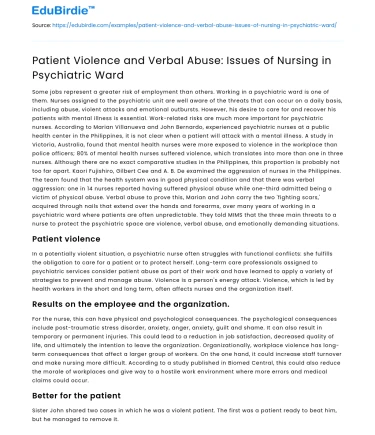Introduction
The issue of patient violence and verbal abuse towards nursing staff in psychiatric wards is a significant concern that affects the safety and well-being of healthcare providers. This problem not only impacts the mental health of the nurses but also the quality of care provided to patients. Violence in psychiatric settings can range from verbal threats to physical assaults, creating an environment of fear and stress for medical staff. According to a study published in the Journal of Psychosocial Nursing and Mental Health Services, approximately 40% of nurses in psychiatric wards experience some form of aggression from patients (Jansen et al., 2018). Understanding the root causes and developing effective strategies to mitigate these incidents are crucial in fostering a safer workplace for nurses and improving patient outcomes. This essay aims to explore the challenges faced by nurses due to patient aggression, the impact on their professional responsibilities, and potential solutions to address these pressing issues.
Understanding Patient Aggression: Causes and Impacts
Patient aggression in psychiatric wards often stems from a complex interplay of psychological, environmental, and systemic factors. Many patients admitted to psychiatric facilities are dealing with severe mental health disorders such as schizophrenia, bipolar disorder, or severe depression, which can manifest as aggressive behavior. Additionally, environmental factors like overcrowded wards, lack of privacy, and high noise levels can exacerbate patients' stress and contribute to violent outbursts. A study by Duxbury et al. (2019) highlights that nearly 60% of aggressive incidents in psychiatric settings are triggered by environmental stressors combined with inadequate staffing levels.
The impacts of patient aggression on nursing staff are profound. Nurses often experience physical injuries, emotional trauma, and psychological stress, which can lead to burnout and high turnover rates. The constant threat of violence affects the nurses' ability to perform their duties effectively, as they may become overly cautious or hesitant in their interactions with patients. This not only compromises the quality of care but also affects the therapeutic relationship between nurses and patients. Furthermore, the fear of violence can create a culture of anxiety within the healthcare team, reducing overall morale and job satisfaction. It is imperative to address these issues comprehensively to ensure both nurse safety and patient care quality.
Strategies and Solutions to Mitigate Violence
Addressing patient violence in psychiatric settings requires a multifaceted approach that includes organizational policy changes, staff training, and environmental modifications. Implementing comprehensive training programs that equip nurses with skills in de-escalation techniques and conflict resolution is essential. According to the International Journal of Mental Health Nursing, such training has been shown to reduce incidents of violence by 30% (Newton et al., 2020). Additionally, enhancing staff-to-patient ratios and ensuring adequate support during high-risk situations can significantly reduce stress levels for both nurses and patients.
Organizational policies should also focus on creating a zero-tolerance environment for violence, where incidents are promptly reported and addressed. Establishing support systems, such as counseling services for nurses who have experienced violence, is crucial in fostering resilience and aiding recovery. Furthermore, environmental modifications, such as redesigning wards to minimize stress-inducing factors, can create a more therapeutic atmosphere. For example, using calming color schemes, reducing noise levels, and ensuring patient privacy can significantly mitigate triggers for aggression.
Counter-Arguments and Considerations
While the strategies mentioned above are effective, critics argue that they may not be sufficient in addressing the root causes of patient aggression. Some suggest that a greater focus on early intervention and comprehensive patient assessments upon admission could preemptively identify those at risk of violent behavior. Additionally, critics highlight the potential financial burden involved in implementing extensive training programs and environmental modifications, especially in underfunded healthcare systems.
However, the long-term benefits of reducing patient violence, such as improved nurse retention rates and enhanced patient care outcomes, can outweigh the initial costs. Investing in preventative measures could also reduce the financial impact of workplace injuries and legal liabilities associated with violent incidents. Therefore, a balance between immediate interventions and long-term strategic planning is essential for sustainable solutions.
Conclusion
In conclusion, patient violence and verbal abuse in psychiatric wards present significant challenges for nursing staff, impacting their safety, mental health, and professional responsibilities. Understanding the multifaceted causes of aggression and implementing effective strategies are crucial for mitigating these issues. While there are counter-arguments regarding the feasibility and financial implications of such interventions, the benefits of a safer and more supportive work environment are undeniable. By prioritizing the safety and well-being of nurses, healthcare institutions can improve the quality of patient care and foster a more positive therapeutic environment. As the complexities of mental health care continue to evolve, ongoing research and adaptive strategies will be vital in addressing the persistent issue of patient violence in psychiatric settings.






 Stuck on your essay?
Stuck on your essay?

